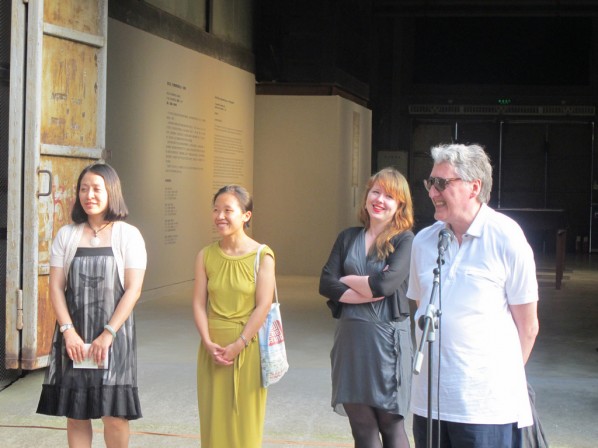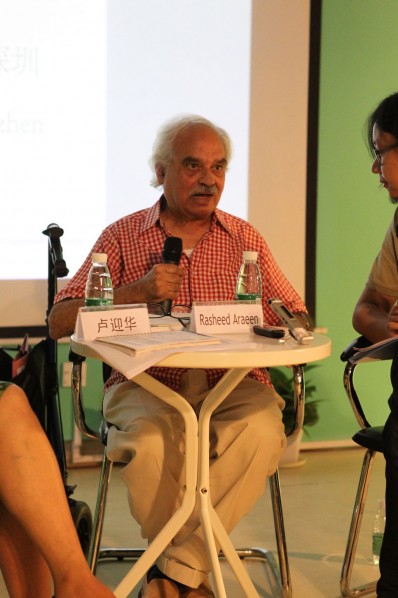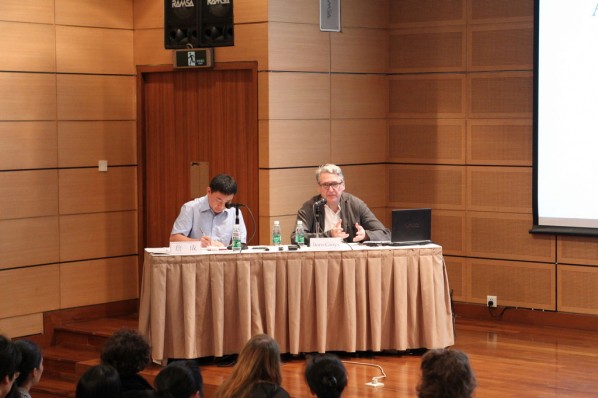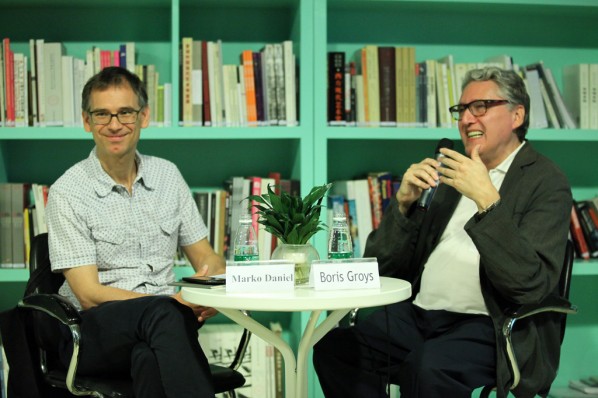
The OCT Contemporary Art Terminal (OCAT) in Shenzhen announced the opening of the research exhibition “After History: Alexandre Kojève as a Photographer” curated by philosopher and critic Boris Groys on the afternoon of September 21, 2012.
For the first time, this exhibition unveils to the Chinese public unique photographic work, which includes nearly 400 photographs taken in the 1950s and 1960s by the Russian-born French philosopher and diplomat Alexandre Kojève. Kojève also traveled extensively in Ceylon (Sri Lanka), China, India, Iran, Japan, Nepal, the Soviet Union, and throughout Western Europe. His journey and lifetime collection of postcards are presented at OCAT as table cloth and slideshows. Before it toured to OCTA, the exhibition was exhibited at BAK, Utrecht from May through to July, 2012 and the 9th Gwangju Biennale, Gwangju, 2012. Through this collection of images, the essence of both Kojève’s philosophical thinking and his political practice is captured. As curator Boris Groys has stated at the press conference, “although Alexandre Kojève believed that he lived in the period of post-history but he loved history. Philosophy is a kind of love, Alexandre Kojève retained his love for historical knowledge and experience in his photography though he worked as a bureaucrat in post-history.”
The collection of both photographs and postcards portray the world as Kojève articulated it through his philosophical thinking: an aesthetically harmonious and exotic East; a stiflingly complete and hollow West; and Russia, Kojève’s rapidly changing homeland, is shown mainly through old churches frozen in time. Through its premiere presentation, the thousands of repetitive images in the exhibition visualize a post-historical world awaiting for an ideal imaginary image of freedom, justice, and equality to be realized through activism. By doing so, it questions the critical capacity for change in our contemporary reality and shows us a global stage that anticipates the achievement of another tomorrow.
[gallery link="file" orderby="title"]
Photographs of Alexandre Kojève were provided by OCAT
©Bibliothèque nationale de France. All rights reserved ©Nina Kousnetzoff
Boris Groys (born 1947) is a philosopher, art critic, essayist, and curator who teaches Russian studies, comparative literature, and contemporary media. He is Professor of Russian and Slavic Studies at New York University, New York and since 1994 he has been Professor of Philosophy and Media Theory at the Karlsruhe University of Arts and Design, Karlsruhe. Appointed co-curator of the 9th Shanghai Biennale, Shanghai, 2012, Groys is also a research advisor for the long-term international research, education, publishing, and exhibition project FORMER WEST (2008–2014). Recent curatorial work includes: Out of Town: Andrei Monastyrski & Collective Actions, e-flux in collaboration with Performa 11, New York, 2011–2012; Empty Zones, Russian Pavilion at the 54th Venice Biennale, Venice, 2011; together with Peter Weibel, Medium Religion, ZKM, Karlsruhe, 2008–2009; and Traumfabrik Kommunismus, Schirn Kunsthallen, Frankfurt, 2003–2004. Groys’ work was shown in the exhibition Thinking in Loop: Three Videos on Iconoclasm, Ritual and Immortality, apexart, New York, 2008. He also directed The Post-Communist Condition research project at ZKM, Karlsruhe and published Das kommunistische Postskriptum (2005) detailing the findings of the project. Other selected publications include: Under Suspicion: A Phenomenology of Media (2012); Introduction to Antiphilosophy (2012); The Communist Postscripts (2010); Going Public (2010); Art Power (2008); Ilya Kabakov: The Man Who Flew into Space from his Apartment (2006); Dream Factory Communism: The Visual Culture of the Stalin Period (2003); and The Total Art of Stalinism: Avant-Garde, Aesthetic Dictatorship, and Beyond (1992). Groys lives and works in New York.
Gwen Parry (born in 1986) works as a project coordinator for the contemporary art institution BAK, basis voor actuele kunst in Utrecht, the Netherlands. Before joining BAK in 2011, she studied art history and political science in Amsterdam and worked for several political participation programs, among others as a youth educator for the Dutch parliament in The Hague. At BAK, she among others coordinated Call the Witness, the 2nd Roma Pavilion at the Venice Biennale, Venice, 2011 and After History: Alexandre Kojève as a Photographer, BAK, Utrecht, 2012 and 9th Gwangju Biennale, Gwangju, 2012. Currently, she is working on the forthcoming publication We Roma: A Critical Reader in Contemporary Art (2013) together with Daniel Baker and Maria Hlavajova, and on the 4th FORMER WEST Research Congress, which will take place at the Haus der Kulturen der Welt [House of World Cultures], Berlin in 2012. Parry lives and works in Amsterdam and Utrecht.
About the Exhibition
Organizer: OCT Contemporary Art Terminal
Curator: Boris Groys
Opening: 5:00 PM, September 21, 2012
Exhibition Date: September 21 – November 16, 2012
Address: OCT Contemporary Art Terminal, Enping Road, Overseas Chinese Town, Nanshan District, Shenzhen, China
Sponsor: Shenzhen Overseas Chinese Town Co., Ltd.
Tel: 0086-0755-2691 5100
Related Lectures and Dialogues
Lecturer: Gwen Parry
Title: Alexandre Kojève and the “Former West”
Time: 2pm-3pm, September 21, 2012
Venue: Library of OCT Contemporary Art Terminal
The year 1989, filled with pivotal planetary changes, has come to symbolize a point of distinction between two historical eras, drawing a line as it were between the Cold War period and the globalized often neoliberal future to come. Francis Fukuyama declared “the end of history” in his infamous 1989 essay, claiming that there would be no new concepts in freedom and equality, no political work and no horizon to strive toward, as we had arrived at “the end point of mankind’s ideological evolution and the universalization of Western liberal democracy as the final form of human government.”
To support his argument, Fukuyama repeatedly invokes the thoughts of philosopher Alexandre Kojève (1902-1968). Before WWII and thus decades before Fukuyama formulated his end-of-history thesis, Kojève equally observed that we were living in post-historical times, but with history coming to a stand-still through the events of the French Revolution, as it had achieved particular individual freedoms and the universal recognition of human desires in the Western world. Believing that under the post-historical condition one should stop thinking about the world and instead improve it, after WWII Kojève abandoned philosophy to work for the French Ministry of Economic Affairs as a chief planner of the European Common Market, which later became the European Union. Remarkably, after this shift from deliberation to action Kojève started to develop his own photographic practice in order to register the post-historical world he saw around him during his many travels in the 1950s and 1960s—the thousands of generic postcards he collected illustrating the repetitive, non-original aesthetics that inspired this artistic style. His work captures an aesthetically harmonious and exotic East, a stiflingly complete and hollow West; and Russia, Kojève’s rapidly changing homeland, is shown mainly through old churches frozen in time.
This division suggested by Kojève’s photographic practice reflects problematic—yet until very recently strongly influential—perceptions of how the world is shaped both philosophically, politically, and aesthetically. The core endeavor of BAK, basis voor actuele kunst’s long-termn project FORMER WEST, of which this is a research exhibition—locating its research in the post-1989 period in order to enable speculation about other global futures—is to challenge such assumed geographical superiorities and discriminate bio-political structures suggested among others by Fukuyama and indirectly by Kojève’s visual portrayal of our global stage. This lecture elaborates how the unveiling of this long-hidden photographic treasure within the framework of this internationally travelling exhibition has the potential to help us rethink and scrutinize our recent past, and crucially speculate about how we could collectively shape tomorrow.

Lecturer: Rasheed Araeen
Title: Rasheed Araeen and His Art
Time: 10:30pm--noon, September 22, 2012
Venue: Library of OCT Contemporary Art Terminal
Rasheed Araeen is a civil engineer, an artist, writer and inventor—with an international patent. As an artist, he began his journey in 1953 and continued to pursue art while studying civil engineering at NED Engineering College in Karachi. After doing some important works in Karachi, seminal to his later pursuits, he left for London in 1964 and has since lived there. In 1965, he pioneered minimalist sculpture—representing perhaps the only Minimalism in Britain. After having been active in various groups supporting liberation struggles, democracy and human rights, he began to write in 1975, and then started publishing his own art journals: Black Phoenix (1978), Third Text (1987) and Third Text Asia (2008). He has also established online versions of Third Text in Cape Town, South Africa, Entitled Third Text Africa, and the Spanish language Tercer Texto in Lima, Peru, both free to their readers. He has curated two important exhibitions: “The Essential Black Art” (1987), “The Other Story” (Hayward Gallery, 1989); and is a recipient of three honorary doctorates (PhDs) from the Universities of Southampton, the East London and Wolverhampton. He is now directing a project that will revise and produce the most comprehensive and inclusive history of art in postwar Britain. He talked about his art career, Third Text and Roundtable questionnaire in this lecture.

Lecturer: Boris Groys
Title: Alexandre Kojève, the Photographer as the Sage
Time: 2:30pm—5:00pm, September 22, 2012
Venue: Lecture Hall of He Xiangning Art Museum, 9013# Shennan Road, Overseas Chinese Town, Nanshan District, Shenzhen
In tandem with the exhibition After History: Alexandre Kojève as a Photographer, OCT Contemporary Art Terminal organized a public lecture by curator Boris Groys. Focusing on Kojève’s rich experience, his prominent status in philosophical studies, and research results of his work, this lecture rethought Kojève’s colorful life. In Photographer as Sage, Boris Groys discusses the photographic work of Alexandre Kojève, Russian born French philosopher, statesman and one of the founders of the EU, and photographer. According to Groys, Kojève believed that we are living in a post-historical condition and Kojève characterized his own attitude as an attitude of the Sage. Kojève’s theory of end of history differed from most other similar concepts, as for him end of history was not located in the future, but rather we have already been living in post-historical conditions since the French Revolution, only “we are not fully aware of this condition yet.” The Sage is somebody who has already satisfied his desire for revolutionary change-a philosopher in a post-revolutionary, post-historical society. The Sage has not to invent a new revolution but to implement the program of the revolution that has already took place. In other words, the Sage deals with the administration of the post-revolutionary state. According to his concept of history, photography then is not fixating a moment in the constant flow of time, rather it represents an immobilized, arrested time (thus Kojève only photographed monuments of the past). It is an already historisized condition that is represented via photography.

The Conversation Between Boris Gorys and Marko Daniel (Non-public)
Time: 10:30 am—noon, September 23, 2012
Venue: Library of OCT Contemporary Art Terminal
Dr. Marko Daniel, Convenor of Adult Programme (Tate Modern and Tate Britain, since January 2011) and Curator of Public Programmes at Tate Modern from May 2006. He was co-curator of Joan Miró, Barcelona and National Gallery of Art, Washington) and curator of a solo show by Taiwanese artist Chen Chieh-jen at Chinese Art Centre, Manchester (October-November, 2010). He also contributed to the catalogue for Sunflower Seeds by Ai Weiwei (Tate Modern, 2010-2011)
He is Vice-Chair of the London Consortium, a unique collaboration between the Architectural Association, the Institute of Contemporary Arts, the Science Museum, Birkbeck College and Tate that offers interdisciplinary research programmes (PhD and MRes) in the humanities.




























